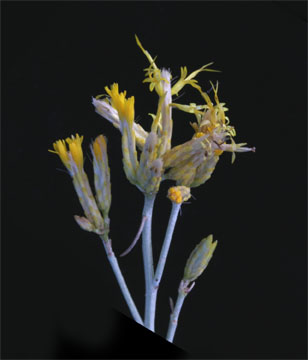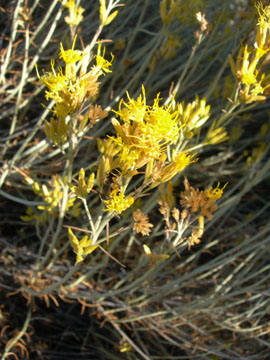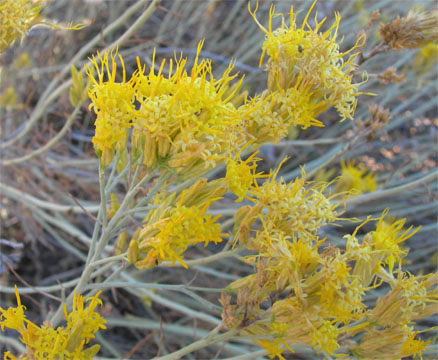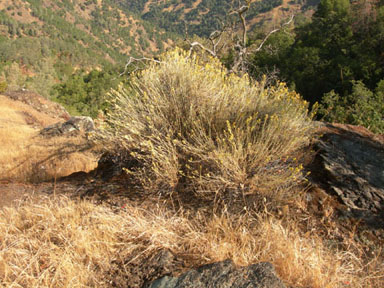
Closeup of the flower of Gray Rabbit Brush

The flowers attract many types of insects. This day (Sept 21, 2009) I counted 8 different species of flies, bees, or butterlies.

Gray Rabbit Brush group of flowers

Gray Rabbit Brush as a whole is about 4 feet wide and 3 feet tall
This specimen was photographed September 12, 2009, growing on Rocky Point, near the cliff edge near the point. There were no leaves seen. Based on the description below and other photos, they must have been lost earlier this season.
California Academy of Sciences: Erect, densely branched shrub 1-3 feet tall. It has long, undivided leaves and felt-covered twigs. Flower heads are yellow, about 1/4 inch across, and form dense clusters. Flowers from August to October. The shrubs or half-shrubs die back to earth each year. Found throughout the Intermountain West and in Bannock County, Idaho. Nuttall reported finding the plant on Lewis' River. The Rabbit-Brush family was first identified by Nuttall. There is a holotype of the Gray Rabbit-Brush at the British Museum. Requires a sunny position and prefers a well-drained sandy soil. Plants do not require a rich soil and they tolerate alkaline soils. A very hardy plant but it prefers a drier climate.
In a note in Helen Sharsmith's thesis (1940) Chrysothamnus nauseosus was first found by Greene on Mount Hamilton in 1893. Sharsmith found it on Copernicus Peak, Colorado Creek, Red Mountains---all in the Mount Hamilton Range but east and a little north of us. It is native to the Rancho Hondo. - Lillian Killian Nelson
![]()
References:
California Academy of Sciences webpage, http://images.google.com/imgres?imgurl=http://www.forthall.net/plants/fragile%2520prickly%2520pear.jpg&imgrefurl=http://www.forthall.net/plants/alpha%2520Plants%2520identified%2520by%2520Nuttal.htm&usg=__T3w1N5WMZHc7TV5YDdj0RmKnQic=&h=353&w=640&sz=61&hl=en&start=1&tbnid=j4lNexWeDGjaBM:&tbnh=76&tbnw=137&prev=/images%3Fq%3DChrysothamus%2Bnauseosus%26gbv%3D2%26hl%3Den%26sa%3DG (accessed on Sept 22, 2009)